|
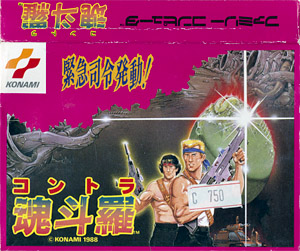
|

|
|
コントラ 魂斗羅
©Konami 1988
Release: 1988-02-09 (¥5300)
Cartdridge RC826
Action/platform
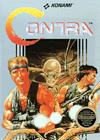

|
Released in America as
CONTRA
( NES-CT-USA )
|
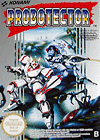
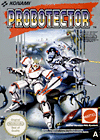

|
Released in Europe as
PROBOTECTOR
( NES-77-XXX )
|
|
Contra (aka Gryzor) is a side scrolling action game by Konami
and based on the arcade game of the same name originally released in 1987. In 2631,
a mysterious meteoroid containing extraterrestrial life crashed through Earth's atmosphere
and landed in New Zealand, near a group of islands. Two years later,
a terrorist group organization known as the Red Falcon appears near the impact
site and threatens to plunge humanity into destruction and chaos. The evil military group
is believed to be helped by a malevolent alien race whose only purpose is to conquer the
universe, and two elite commando marines (Bill Rizer and Lance Bean) are
dispatched on a life-or-death mission to save the world. The fighters have the ability to
jump, crouch, fire in eight directions and also move while using a weapon. They however
have no shield energy nor life bar, and die in one hit. But the meat of the game lies
elsewhere. Contra is popularly known for its serious fire-power on display, and
although players start their mission equipped with a basic and ordinary rifle gun, more
sophisticated and destructive weapons can be obtained throughout the game. Various large
containers stamped with Red Falcon insignias on them release all kind of weapons
with limitless ammo - Flamethrower (F), Laser Gun (L), Machine Gun (M)
and 5-way Spread Gun (S). Special icons also give the players additional abilities,
such as Rapid Fire (R) which increases the weapon's rate of fire, and the Barrier
(B) which turns the player invincible for a short amount of time. Interestingly, although most
of the game is played in a traditional 2D side-scrolling style of gameplay, the second and
fourth levels switch to a 3D over-the-shoulder corridor perspective, and ask the players to
fight their way through heavily defended rooms and corridors. Contra includes a
two-player cooperative mode.
|
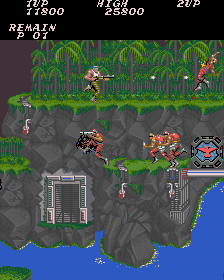 The arcade game Contra (aka Gryzor in Europe) was originally released in 1987 (picture on the right).
The game was then ported to the Famicom (1988), Commodore 64 (1988),
PC Dos (1988), MSX (1989), and was also released under the name 'Gryzor'
in Europe for the ZX Spectrum (1987), Amstrad CPC (1987) and Commodore 64 (1988).
Interestingly, although Contra was known as 'Gryzor' in Europe, the NES
port was curiously renamed 'Probotector' and was heavily censored. Finally,
Contra was also released in 2006 for the Playstation 2 and part of Hamster's
Oretachi Geisen Zoku series. Then the arcade game Super Contra followed in 1988 and
takes place a year after the events depicted in the first game. Although the game is fairly similar
to the first opus, Konami replaced the 3D over-the-shoulder stages by more traditional
overhead levels. Super Contra 2 was also ported to the Famicom in 1990, and was
renamed 'Super C' in the United States and 'Probotector II Return of the Evil Forces'
in Europe. It was also released for the Amiga (1990) and PC DOS (1990). As a side note,
a version of Contra
followed for the Game Boy in 1991. It was renamed Operation C in the US and Probotector in Europe,
and was later included in Konami GB Collection Vol.1 (Game Boy Color, 1997).
The official third Contra followed in 1992
for the Super Famicom and was called Contra Spirits (aka Contra III The Alien Wars in the US
The arcade game Contra (aka Gryzor in Europe) was originally released in 1987 (picture on the right).
The game was then ported to the Famicom (1988), Commodore 64 (1988),
PC Dos (1988), MSX (1989), and was also released under the name 'Gryzor'
in Europe for the ZX Spectrum (1987), Amstrad CPC (1987) and Commodore 64 (1988).
Interestingly, although Contra was known as 'Gryzor' in Europe, the NES
port was curiously renamed 'Probotector' and was heavily censored. Finally,
Contra was also released in 2006 for the Playstation 2 and part of Hamster's
Oretachi Geisen Zoku series. Then the arcade game Super Contra followed in 1988 and
takes place a year after the events depicted in the first game. Although the game is fairly similar
to the first opus, Konami replaced the 3D over-the-shoulder stages by more traditional
overhead levels. Super Contra 2 was also ported to the Famicom in 1990, and was
renamed 'Super C' in the United States and 'Probotector II Return of the Evil Forces'
in Europe. It was also released for the Amiga (1990) and PC DOS (1990). As a side note,
a version of Contra
followed for the Game Boy in 1991. It was renamed Operation C in the US and Probotector in Europe,
and was later included in Konami GB Collection Vol.1 (Game Boy Color, 1997).
The official third Contra followed in 1992
for the Super Famicom and was called Contra Spirits (aka Contra III The Alien Wars in the US
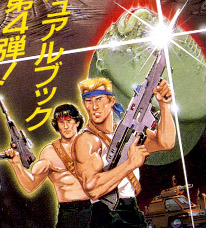 and Super Probotector Alien Rebels in Europe). This sequel improved upon the first games in many ways and
also featured two top-down view stages. As a side note, Contra Spirits was ported to the
Game Boy system in 1994 and was renamed Contra The Alien Wars in the US and
Probotector 2 in Europe. Another port for the Game Boy Advance was released in
2002 - however, Contra Hard Spirits (aka Contra Advance The Alien Wars EX) lost all
the top-down levels and borrowed levels from Contra Hard Corps (Megadrive, 1994).
Anyway, back in 1992, another episode in the series was exclusively released in
the United States for the NES. Contra Force, as it was called, doesn't seem to
have any real ties with the other games in the series. Interestingly, it was originally designed to be a generic
run'n gun called Ark Hound in Japan, but the project was eventually canceled and the game
was later released in the US as Contra Force. The official sequel to Contra III was
Contra The Hard Corps (Aka Probotector in Europe) released for the Sega Megadrive
in 1994 (interestingly, Hard Corps was apparently turned into a spin off series, and a prequel
to the game called Hard Corps Uprising was released by Konami in 2011 for the
Playstation Network and Xbox Live). Then, curiously, Konami relied on a third
party developer to continue growing their video game franchise in the United States and
Europe - however, Contra Legacy of War (Sony Playstation,1996 and
Sega Saturn, 1997) and C The Contra Adventure (Sony Playstation, 1998) are
total disgraces to the entire series. Shin Contra (aka Contra Shattered Soldier),
a true sequel to Contra that does complete justice to the series, was finally released by
Konami in 2002 for the Playstation 2. It was followed by Neo Contra in 2004
for the Playstation 2, which took the series in a different direction that may not completely appeal
to the most hardcore fans... Finally, Contra Dual Spirits (aka Contra 4
in the US) was released for the Nintendo DS in 2007, and Contra Rebirth was
released for WiiWare in 2009.
As a side note, an arcade remake of Contra was given a limited release in China in 2011.
Interestingly, the game was apparently produced by Konami, featured HD resolution
(wide screen 16:9 aspect ratio) and four selectable characters. Information about this release
is rather thin though...
and Super Probotector Alien Rebels in Europe). This sequel improved upon the first games in many ways and
also featured two top-down view stages. As a side note, Contra Spirits was ported to the
Game Boy system in 1994 and was renamed Contra The Alien Wars in the US and
Probotector 2 in Europe. Another port for the Game Boy Advance was released in
2002 - however, Contra Hard Spirits (aka Contra Advance The Alien Wars EX) lost all
the top-down levels and borrowed levels from Contra Hard Corps (Megadrive, 1994).
Anyway, back in 1992, another episode in the series was exclusively released in
the United States for the NES. Contra Force, as it was called, doesn't seem to
have any real ties with the other games in the series. Interestingly, it was originally designed to be a generic
run'n gun called Ark Hound in Japan, but the project was eventually canceled and the game
was later released in the US as Contra Force. The official sequel to Contra III was
Contra The Hard Corps (Aka Probotector in Europe) released for the Sega Megadrive
in 1994 (interestingly, Hard Corps was apparently turned into a spin off series, and a prequel
to the game called Hard Corps Uprising was released by Konami in 2011 for the
Playstation Network and Xbox Live). Then, curiously, Konami relied on a third
party developer to continue growing their video game franchise in the United States and
Europe - however, Contra Legacy of War (Sony Playstation,1996 and
Sega Saturn, 1997) and C The Contra Adventure (Sony Playstation, 1998) are
total disgraces to the entire series. Shin Contra (aka Contra Shattered Soldier),
a true sequel to Contra that does complete justice to the series, was finally released by
Konami in 2002 for the Playstation 2. It was followed by Neo Contra in 2004
for the Playstation 2, which took the series in a different direction that may not completely appeal
to the most hardcore fans... Finally, Contra Dual Spirits (aka Contra 4
in the US) was released for the Nintendo DS in 2007, and Contra Rebirth was
released for WiiWare in 2009.
As a side note, an arcade remake of Contra was given a limited release in China in 2011.
Interestingly, the game was apparently produced by Konami, featured HD resolution
(wide screen 16:9 aspect ratio) and four selectable characters. Information about this release
is rather thin though...
|
|
There are a few differences between the original arcade game and the Famicom
conversion tested here. The first obvious change is the screen aspect ratio - the original arcade game features
a vertical screen and the horizontal screen of the Famicom port arguably suits the gameplay
better. Thinking about it, it is rather surprising that the original arcade game used such ratio in
the first place, this feature is typically reserved for vertical shooters. The 3D over-the-shoulder
corridor levels are also a bit more complicated and ask the player to turn left or right at the end
of each room. Weapons are scattered differently throughout the maps, and there seems to more emphasis
on the Laser. There's only six levels (but the game's content is the same), and their
layouts are also different - for instance the large two-headed statue at the end of the waterfall
stage was replaced by a one headed Alien-inspired monster. The last stages are also completely
different - in the arcade version, the last three levels are played in one breath (which explains
why there's only six stages), and the bosses have been shuffled around (the robot-shuttle appears
at the beginning of the snow field, the armored colossus appears twice and the defense system found
at the end of the Famicom's Stage 7 doesn't appear in the arcade game). As a side note,
the snow field also doesn't feature a blizzard and snowflake animation in the arcade game, unlike the
Famicom conversion. Although the arcade game has more features in store (better graphics,
more objects on screen, players can fire in sixteen directions), the Famicom port is often
regarded as superior, with a much more responsive and intense gameplay.
|
For some obscure reasons, the American and European releases of the game were edited.
The game's plot was entirely changed in the America version of the game. The setting was
changed - the meteoroid crashed in 1957 and the action takes place thirty years later, in 1987.
The mission's location was moved to South America near a Mayan
temple (instead of New Zealand and a fictional island). Interestingly this
alternate plot was later abandoned, and new games developed under the Contra franchise
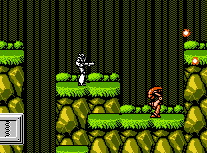 later followed the original Japanese's story. The European
version met a very different fate though and was renamed 'Probotector'. Although the story
plot is fairly close to the Japanese game, the player and enemy graphics were edited and all
of them turned into robots (probably due to some form of censorship). Both American and
European versions lost the introduction sequence played at the beginning of the game, as
well as the game's map (displayed between levels) or the end of level animations
(featuring Bill and Lance). The end sequence was also edited, and the full screen
helicopter scene played before the island's ultimate explosion was entirely removed. Also, the
Famicom original includes a couple of special effects not found on the America
nor European versions - such as palm-tree leaves blowing in the wind (level 1), the
howling blizzard, moving tree leaves and falling snow (level 5) or the pulsating walls from
the Alien's Lair (Level 8). This is due to the VRC2
special mapper chip included in the Japanese cartridge, and completely removed from the
international releases (probably to reduce production costs). Finally, a few of the cheat codes
from the Japanese version were completely removed.
later followed the original Japanese's story. The European
version met a very different fate though and was renamed 'Probotector'. Although the story
plot is fairly close to the Japanese game, the player and enemy graphics were edited and all
of them turned into robots (probably due to some form of censorship). Both American and
European versions lost the introduction sequence played at the beginning of the game, as
well as the game's map (displayed between levels) or the end of level animations
(featuring Bill and Lance). The end sequence was also edited, and the full screen
helicopter scene played before the island's ultimate explosion was entirely removed. Also, the
Famicom original includes a couple of special effects not found on the America
nor European versions - such as palm-tree leaves blowing in the wind (level 1), the
howling blizzard, moving tree leaves and falling snow (level 5) or the pulsating walls from
the Alien's Lair (Level 8). This is due to the VRC2
special mapper chip included in the Japanese cartridge, and completely removed from the
international releases (probably to reduce production costs). Finally, a few of the cheat codes
from the Japanese version were completely removed.
|
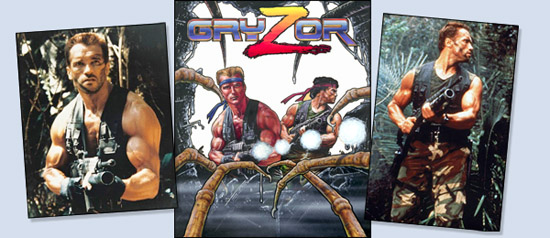
The Americam cover art was designed by the talented British freelance artist Bob Wakelin. This
part is rather interesting - Ocean Software produced ports of Contra for the European
market and renamed the game 'Gryzor' (which was the name of the arcade game in Europe).
They converted the game for the Commodore 64,
Amstrad CPC and ZX Spectrum between 1987 and 1988. Logically, Bob Wakelin
(prolific artist for Ocean and Imagine, also known for his excellent cover work such as
Cabal, Elf, Epic, Ninja Gaiden, Rainbow Islands, Operation Wolf
and so forth) was commissioned to paint the cover art. His inspiration is rather clear - in his own words,
"a Predator/Alien rip-off is what the game appeared to be, so I supplied a Predator/Alien style pic -
with ripped Arnie Predator poses". And this was a valid point, the original characters Bill and Lance
were undoubtedly based off Arnold Schwarzenegger and Sylvester Stallone. Although he mentions
that the cover was a "thoroughly boring job to do", his art was also used for the American NES
release of the game and can even be seen at the back of the Japanese MSX2's box cover, or
the LCD game released by Konami in 1989! (see the 'Goodies' section)
|
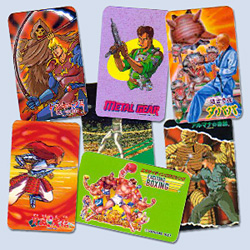 Like several other early Konami games released in the 1980s/1990s, Contra
included a numbered collector card also known in Japan as コナミ キャラカード (aka 'Konami Chara Cards' or 'Konami Character Cards').
Each card featured an illustration or a snapshot
from the game (picture on the right), and the back of each card showed a serial number as well as the
game's title. They were randomly included with the games and Konami
produced several variations of each card. That's it, each game included a
card from a series related to the game, it is however not known
how many different card variations were made for each game.
Apparently six cards (on average) were produced for each game, except
for Doremikko (1 card), Exciting Boxing (1 card) and Meikyujin Dababa
(which, curiously, only seem to feature five cards).
The list of
Konami games to include such cards are believed to be :
Ai Senshi Nicol (FDS),
Dracula II Noroi no Fuin (FDS),
Arumana no Kiseki (FDS),
Contra (FC),
Doremikko (FDS),
Dragon Scroll (FC),
Exciting Baseball (FDS),
Exciting Basketball (FDS),
Exciting Billard (FDS),
Exciting Boxing (FDS),
Exciting Soccer (FDS),
Falsion (FDS),
Getsu Fūma Den (FC),
Majō Densetsu II Daimashikyō Galious(FC),
Meikyū Jiin Dababa (FDS),
Metal Gear (FC),
Salamander (FC),
Tetsuwan Atom (FC),
Top Gun (FC)
and Wai Wai World (FC).
Like several other early Konami games released in the 1980s/1990s, Contra
included a numbered collector card also known in Japan as コナミ キャラカード (aka 'Konami Chara Cards' or 'Konami Character Cards').
Each card featured an illustration or a snapshot
from the game (picture on the right), and the back of each card showed a serial number as well as the
game's title. They were randomly included with the games and Konami
produced several variations of each card. That's it, each game included a
card from a series related to the game, it is however not known
how many different card variations were made for each game.
Apparently six cards (on average) were produced for each game, except
for Doremikko (1 card), Exciting Boxing (1 card) and Meikyujin Dababa
(which, curiously, only seem to feature five cards).
The list of
Konami games to include such cards are believed to be :
Ai Senshi Nicol (FDS),
Dracula II Noroi no Fuin (FDS),
Arumana no Kiseki (FDS),
Contra (FC),
Doremikko (FDS),
Dragon Scroll (FC),
Exciting Baseball (FDS),
Exciting Basketball (FDS),
Exciting Billard (FDS),
Exciting Boxing (FDS),
Exciting Soccer (FDS),
Falsion (FDS),
Getsu Fūma Den (FC),
Majō Densetsu II Daimashikyō Galious(FC),
Meikyū Jiin Dababa (FDS),
Metal Gear (FC),
Salamander (FC),
Tetsuwan Atom (FC),
Top Gun (FC)
and Wai Wai World (FC).
|
Teaser text copied from the American version:
Pitted against the galaxy's
fiercest foe, you either win
or the whole world loses.
The universe teeters on the brink of
total annihilation at the hands of the
vile alien war monger, Red Falcon.
Earth's only hope rests with you, a
courageous member of the Special
Forces elite commando squad.
Your mission: Battle deep into the
deadly Amazon Jungle, where the
Red Falcon and his galactic henchmen
have transformed ancient Mayan
temples into awesome monuments
dedicated to mass destruction.
A multitude of weapons, from
rapid-fire machine guns to high-tech
lasers, are at your disposal as
you sweat blood, fighting past
3-D mazes, underground security
systems and tropical forests
surrounded by giant waterfalls
and alien cannons.
This is the ultimate test for the
ultimate guerrilla warrior. And if
you survive, Earth survives.
|
Teaser text copied from the European version:
Pitted against the galaxy's
fiercest foe, you either win
or the whole world loses.
It's the year 2633 A.D. Technology
has reached a level so advanced
that nature and science now exist
in harmony and peace reigns
throughout the world.
... but beneath the calmness
something beyond all imagination
is discovered that threatens
the existence of mankind.
While conducting top secret
research, a special task force of
scientists find that an alien being
from the Galaxy of Apocalypse is
plotting to wipe out the human race.
In order to protect the Earth and
its people, two combat robots
(Probotectors), RD008 and
RC011, have been developed.
Their mission is to go to the alien's
fortress in the Galga islands and
see that they are exterminated.
|
Game Staff (Copied from the end credits) :
|
STAFF
Programmers
S. Umezaki
S. Kishiwada
K. Yamashita
T. Danjyo
M.Ogawa
|
|
Graphic Designers
T.Ueyama
S. Muraki
M. Fujiwara
T. Nishikawa
C. Ozawa
|
|
SoundCreators
H. Maezawa
K. Sada
Special Thanks To
K. Shimoide
N. Sato
AC Contra Team
|
|
Directed by
Umechan
S. Kitamoto
KONAMI
|
|
G
O
O
D
I
E
S
|
|
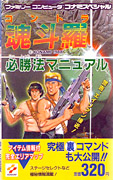
Japanese Guidebook
|
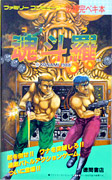
Japanese Guidebook
|
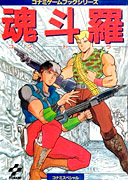
Japanese Gamebook
|
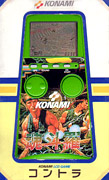
Japanese LCD Game
|
|
|
O
M
A
K
E
|
|
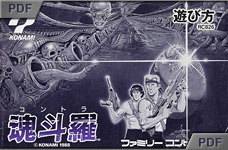
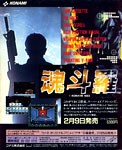
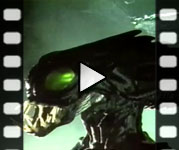
|
|
|
Click on picture to enlarge |
S
E
C
R
E
T
S
|
|
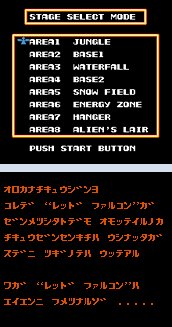 Konami code (30 Lives):
Konami code (30 Lives):
Contra is often believed to be the first game to feature the now immensely
popular Konami Code. Contra was really popular among gamers, and this
may explain why the run'n gun was associated with Konami's cheat code (it is
now widely accepted that the first game to feature the Konami Code was the
Famicom port of Gradius released in 1986). Anyway, at the title screen,
press up, up, down, down, left, right,
left, right, B and A - the game
will then award you with thirty lives.
Level Select Mode (Japan only):
This cheat only works for the Japanese version of the game. At the title screen, hold up,
left and A - then press Start and Select. This is rather tricky to achieve,
make sure you press Start once, then release it and quickly press and hold Select,
while still holding Left, Up and A).
The level selection screen will then appear (picture on the upper-right).
Sound Mode (Japan only):
This cheat only works for the Japanese version of the game. At the title screen, hold A and
B, then press Start. The sound mode selection screen will appear.
Secret Ending (Japan Only):
During the staff roll, press and hold Start and Select, and wait for the credits to end.
The screen will flash and a new message from the Red Falcom terrorist group will then
appear (picture on the lower-right).
|
|
|
|
|
LK

|
|
Add your Pov here !
|
P
O
V
s
|
|
Although Contra somewhat rips off the Alien movie series without shame,
it is a masterpiece of gameplay design and amazingly well crafted controls. It is also
a rare example of a game that improves upon the arcade game it was meant to copy.
Everything in the game flows with sublime perfection (except maybe for the 3D over-the-shoulder
levels which feel a bit out of place). Controls allow you to fire in any direction while moving,
which greatly contributes to the game's sense of speed and satisfying fun. Although Contra
empowers the player with ludicrous firepower, it also knows how to take it back and the instant
death rule is definitively the game's toughest challenge. Contra is a tough nut to crack
for sure, but everything in the game is about fast-paced action that keeps your adrenaline pumping,
and in the end, the difficulty never really feels unfair or cheap. Konami has a fine tradition
of producing quality games, and Contra, I believe, has gone above and beyond their
call of duty, and is a criterion of precise gameplay mechanics and intense shooting action.
A must have.
|
|
|
|